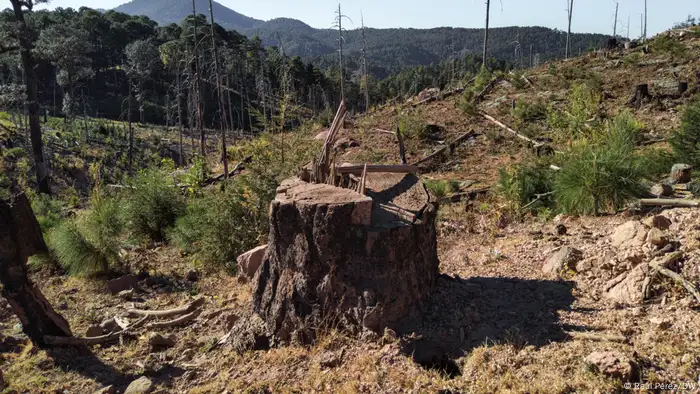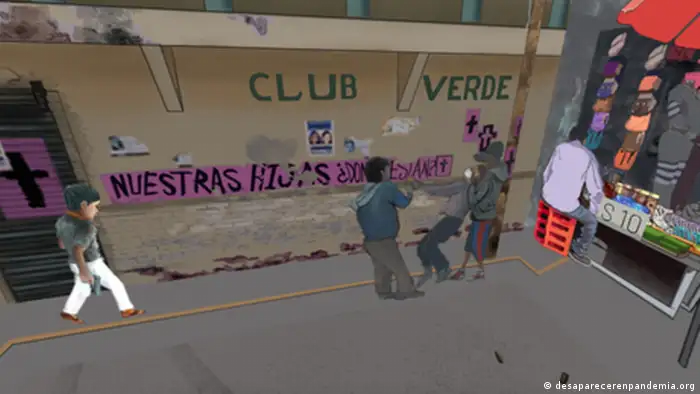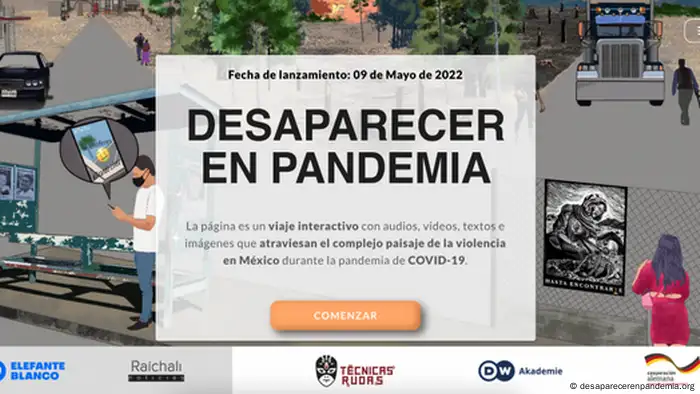Latin America
Enforced disappearance: Digital art and journalism break the silence
The Corona pandemic has also impacted enforced disappearance in Mexico. Four investigative reports present the new realities using both art and journalism.
"Whoever dies a violent death here is forgotten," writes the Mexican journalist Patricia Mayorga about Ciudad Juárez, a city close to the Mexico-U.S. border which has become known as the 'place of disappeared women'. Since the start of the pandemic, violence there has spiraled: In the downtown area alone, 59 people have been killed.
Mayorga learned that in the pandemic’s shadow, so-called ghost hotels were returning to life. Already a decade ago, the scene had been set for sexual exploitation, human trafficking and femicide before the smuggling rings responsible for the crimes were apprehended. Hundreds of young women disappeared then and were either found dead or not found at all. Since the hotels reopened, Mayorga’s sources report suspicious occurrences and cries in the night. People there fear that history is repeating itself.
The New Normal is transforming organized crime
Whoever has an interest in descending into Ciudad Juárez’s bleak ambience can do so via the 3D website of the project 'Disappearance in the pandemic'. Mayorga’s reportage is one of four stories from the Técnicas Rudas research project, which is supported by DW Akademie. The stories illustrate how Mexico’s drug trade and black market benefited from the pandemic, which also worsened the country’s already precarious economic situation. They also show how organized crime developed new markets, such as illegal timber from the state of Chihuahua, where also activists in indigenous areas simply vanished without a trace.

Fear of organized crime associated with illegal logging is forcing entire families in Guadalupe to move to other communities in Mexico
The research team reports moreover on the disproportionately high number of disappeared along one of the most important trade routes in the country, in the state of Tamaulipas, where last year in the section between Monterey and Nuevo Laredo more than 75 people were reported missing. And they make clear that organized crime has spread online. For instance, in social networks which attract young people, promising job offers are posted but all of them lead into forced labor.
Already at the pandemic’s onset, there were multiple predictions that border closures and lockdowns would have consequences for how organized crime networks run their businesses. The Técnicas Rudas team also suspected that this would affect violent disappearances. But working on the basis of conjecture as to how criminal organizations would change how they work proved difficult, with the challenge being that potential sources were afraid to talk. It’s also dangerous to report on this. And since many media companies don’t act independent of political interests, there are blind spots built into covering this stories. The mainstream media barely report on enforced disappearance, and when they do, they further stigmatize the victims with their reporting. Both the media and political criminalization of the victims reinforces the silence surrounding these crimes, explains Philippa Williams of Técnicas Rudas, coordinator of the project 'Disappearance in the pandemic'.
An alliance to break the silence
Enforced disappearance in Mexico barely register with the public. "If the story is ‘25 people were shot in a bar’, there’s public interest," says Williams. ‘But fewer victims than that hardly fazes Mexicans, they have become jaded with it all."
Her team of reporters and artists pose a fundamental question: How has the pandemic affected enforced disappearance among Mexican citizens? In this, they turn investigative journalism interactive, into life’s digital sphere, hoping to advance this crime against humanity into the public consciousness.
The goal is to contribute to the public discourse and the development of free opinions within Mexican society, to support DW Akademie’s local partner Técnicas Rudas to break the silence surrounding violent disappearance using innovative means.
UN report: Fighting enforced disappearance with transparency
On an average day in Mexico, 28 people are forcibly and violently abducted. A recent report by the UN Conference on Environment and Development (CED) documented these numbers amid the deepening human rights crisis in Mexico. The report specifically identifies organized criminality, but also points to federal, regional and local government officials as being responsible for these crimes through complicity, tolerance or forbearance. Some 98 percent of all crimes in Mexico go unprosecuted, according to the UN report which describes this as a structural problem with a passive judicial system and a chronic lack of resolution.
The UN report recommends, among other things, making enforced disappearance visible so as to better inform the public of these crimes – and thereby to better combat them.
Art and journalism turn symbiotic
Técnicas Rudas’ research team had precisely that goal: to galvanize with a new and creative approach and thereby raise awareness. The team spotlighted the current news on organized crimes, analyzing social networks and speaking with about 30 non-governmental organizations, survivor groups and experts dealing with security issues. They discovered a recurring pattern and details, and settled on following four clues. Experienced journalists who know the local milieu well conducted research under strict security measures – accompanied by artists.
"This cooperation with artists gives journalists new options to convey the urgency of their research results," explains Williams. Using Patricia Mayorga’s research material, a song, podcast and video was crafted as well as 3D illustrations which can be viewed in a virtual space of Ciudad Juarez on the project’s website. Visitors find themselves in Ciudad Juarez’s downtown, they hear the market sounds and see the missing persons posters.
Digital art makes journalistic research tangible and changes the public’s role: Instead of consuming content, they’re called upon to interact. This change of perspective results from a change in format: from a traditional journalistic format to a varied format that can reach across the spectrum of humanity.
"The stories we deal with everyday are very painful. It means a lot to me that a certain wisdom and beauty can come out of this all," says journalist Mayorga.
DW Akademie has worked with in Mexico since early 2020. The independent local organization supports the victims of enforced disappearance in Mexico through strategic research and forming partnerships. DW Akademie’s goal is to make human rights topics more visible to the general public. The project is funded by the Federal Ministry for Economic Cooperation and Development.
DW recommends
- Date 05.07.2022
- Author Lena Gamper
- Feedback: Send us your feedback.
- Print Print this page
- Permalink https://p.dw.com/p/4DhEt
- Date 05.07.2022
- Author Lena Gamper
- Send us your feedback.
- Print Print this page
- Permalink https://p.dw.com/p/4DhEt


